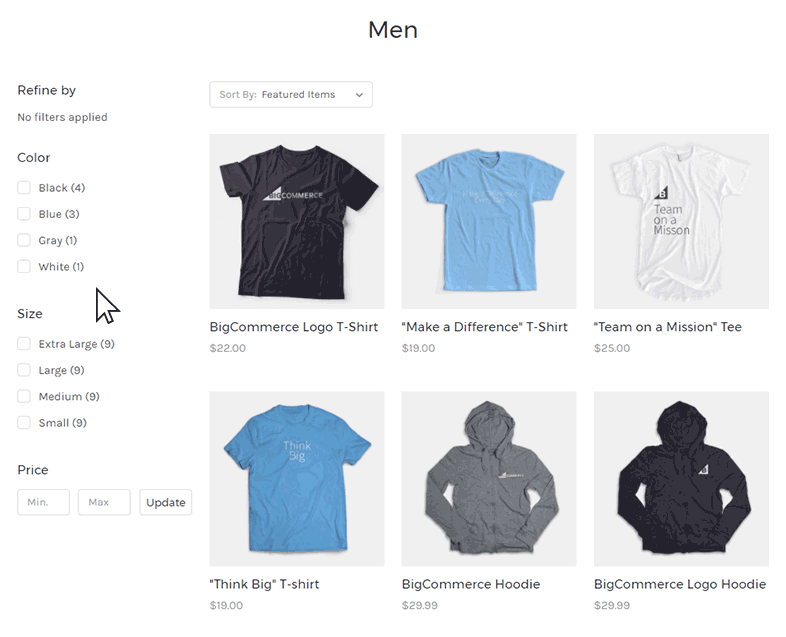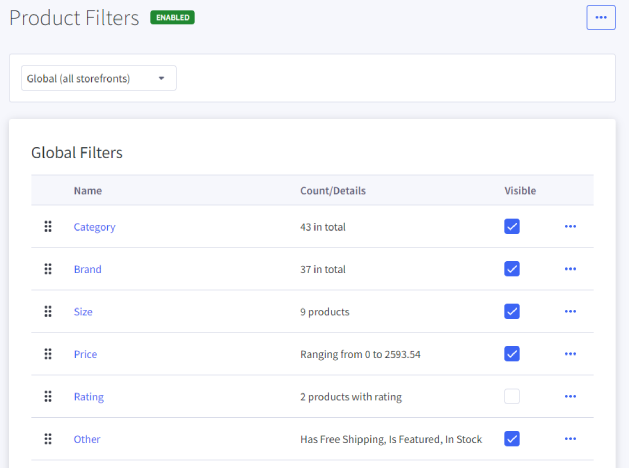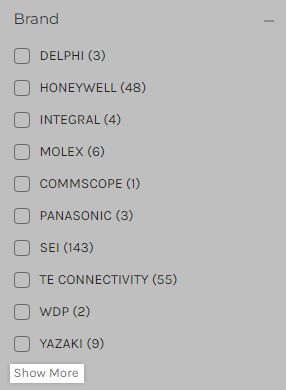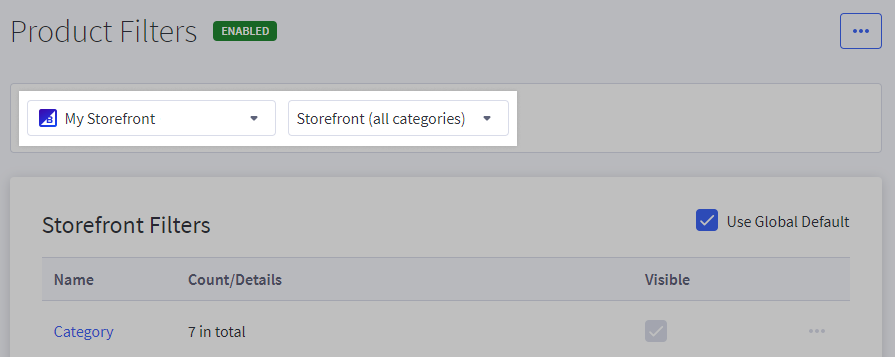Product Filtering
Product Filtering (also known as faceted search) allows shoppers to refine product searches based on multiple attributes like price, color, size, and reviews. Using filters on your storefront can make it easier for shoppers to navigate products by allowing them to search the way they want to.
Product filters appear on category, brand, and search pages.

Requirements
Your store must meet the following criteria in order to use product filters:
- Your store must be on a Pro and Enterprise plan. See Changing Your Store’s Plan for help in upgrading.
- You must use a supported theme. Product filtering is supported by all Stencil themes.
- You must have the Manage Settings permission enabled in your user account.
How It Works
Once product filtering is enabled for your store, a list of all available filters is automatically generated in Products › Product Filtering. New filters are also generated whenever new criteria (such as product options or custom fields) are added to your products.

In your Product Filters list, you can manage which filters appear in the storefront, set category-specific filters, and change the sort order for the filter values. See Setup and Settings for more information.
Filters will only display on a storefront page if there are products available with those attributes. Each filter can have an unlimited number of values (such as red, green, and blue for a color filter), but only up to 500 of the most commonly-used values will be displayed in the storefront. If a filter has more than 15 values, additional values are displayed under a Show More link.

Filter Types
Your storefront can display up to 12 filters on any particular page. You can set which filters should appear by default for your entire storefront, and optionally customize which filters appear for each of your store’s categories. This is helpful if your store’s categories contain diverse products, which your shoppers may wish to filter by different criteria.
- Category — filters by product category or sub-category; only used on Brand and Search pages
- Brand — filters by the product brand
- Price — filters by the base price of the product; does not include variant prices
- Rating — filters by product review rating; must be using BigCommerce’s product reviews
- Other — enables additional filters:
- Products with free shipping
- Featured products
- Products that are in stock
- Product Options — filters by product options. To ensure option filters include all applicable products, we recommend making the spelling and case of option names and values consistent across your catalog.
- Custom Fields — filters by custom fields on products. Product options and custom fields that share the same name will be treated as a single filter. If names differ in case or spacing, they will be treated as different filters.
Setup and Settings
Go to Products › Product Filtering to enable Product Filtering.
Use the channel selector at the top of the page to select which channel/storefront you want to set up filters for. Then, use the category selector to switch between editing all categories or editing an individual category using contextual filters.

Click the checkbox under Visible to enable/disable a filter from showing on the storefront.

Edit the settings for each filter by clicking the ⋯ settings menu to the right.

Each filter will contain a combination of the following settings:
- Display name — the label for the filter as it appears on your storefront
- Sort — determines whether the option values for the filter are displayed alphabetically, by option value order, or by item count.
- Alphabetically — alphabetized by value name, such as blue, green, red, and yellow
- By option value order — the order of values defined when creating or editing an option
- By item count — sorted by the number of products that share this value, from highest to lowest
- Show — the number of filter option values to display (5, 10, or 15). If you have more than 15 values in an option, a Show More link will display to allow customers to show all values.
- Display Product Count — displays the number of matching products in parenthesis
- Collapsed by default — determines whether the filter is collapsed (closed) by default and requires the customer to click it to see its options.
Your filters show on the storefront in the same order they appear in the control panel. You can rearrange filters by dragging and dropping them.
Product listing limits: When Product Filtering is enabled, product listing pages in the control panel and on the storefront are limited to displaying 10,000 products.
Contextual Filters
By default, categories will use your Storefront (all categories) filter settings. If you want to customize the filters that appear on a particular category, select the category from the dropdown list at the top of the page, then uncheck Use Storefront Default.

FAQ
What are some use cases for product filtering?
A price filter would be useful for a customer primarily looking for good value, while a customer coming to your store to browse exclusive brands would benefit from a brand filter. Some shoppers have specific variants in mind such as size or color, so having a filter based on product options would allow these customers to search more efficiently.
How can I use custom fields as filters?
Custom fields allow you to specify additional information that appears on product pages. Used in conjunction with product filtering, this information can be used by shoppers to find products quicker and easier.
For example, a merchant might sell baseball cards. Each card/product has custom fields for attributes like team, year, and position. Using product filtering and custom facets, shoppers could limit their search to Red Sox cards from 2007.
By allowing shoppers to filter by the facets that are important to them, they can quickly find the products they're looking for, increasing the chance they'll ultimately make a purchase.
How can I hide out of stock options from product filtering search results?
Go to Settings › Inventory in the control panel. For when an option is out of stock, select Mark the option as out of stock. This opens up an additional option to hide options in product filtering results. Enabling this setting allows only in-stock options to show for customers using product filtering, resulting in search results with greater relevance for shoppers.
Why aren't my filters visible in the control panel?
If some or all of your filters are missing in Products › Product Filtering by default, contact our support team to have them manually restored.
Why are my facet product count values larger than the number of products displayed?
Currently, products in categories hidden by Customer Groups will contribute to facet product counts. Only the count value is affected and the products themselves will remain hidden.
 © Copyright 2003 - 2024 BigCommerce Pty. Ltd. Shopping Cart Software
© Copyright 2003 - 2024 BigCommerce Pty. Ltd. Shopping Cart Software